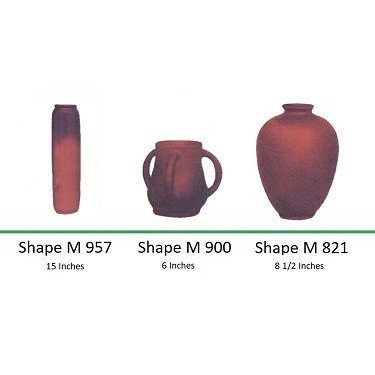
Collectors Guide to Roseville Pottery Mongol, 1904-1906
What is Mongol?
Mongol is a line of art pottery produced from 1904 through 1906 by the Roseville Pottery Company in Zanesville, Ohio.
Who designed Mongol?
The Mongol line was developed by John Herold.
The Roseville Pottery Mongol line was a response to perceived demand for pottery that could duplicate the difficult to obtain Chinese Oxblood pottery. Hugh Cornwall Robertson of the Chelsea Pottery Company was awarded the Grand Prix for his Twin Stars of Chelsea vases in the 1904 St. Louis Exposition. These two vases are considered the first successful metallic oxblood created in modern times, created in 1896. One of the vases can be viewed at the Museum of Fine Arts in Boston.
The official title of the Chelsea glaze was "Sang De Boeuf" which translated to "Oxblood Red". Most Mongol pieces do not display the metallic sheen of the Chelsea vases, and are rather uniform in the glaze application. Some pieces do display a slight tonal shift from the top to the bottom. They were generally sold undecorated, however a few under-glaze decorated pieces have surfaced.
Roseville Pottery was awarded a silver medal for the Mongol line in the 1907 Jamestown Exposition, in Norfolk, Virginia.
Even as the line gained accolades for its unique glaze, the purchasing public were not swayed. Many boxes of unsold returns from dealers languished in the Roseville warehouse, where they were later used as practice blanks for aspiring artists. These pieces can be occasionally found re-glazed and re-fired with poor-quality artwork, the Mongol red changed to blues and purples by the re-firing process.
When was Mongol made?
The Mongol line was only produced in 1904 through 1906.
Our information of the Mongol offerings comes from a 1905 Roseville pamphlet. The pamphlet displays 10 images of the Mongol line, all shapes that were used in the standard Rozane Royal line as well. There were perhaps a dozen other Rozane Royal shapes sold with the Mongol glaze, as evidenced by their existence in museums and private collections. They often have the Rozane wafer on the bottom, with "Mongol" in the bottom rocker, but are occasionally unmarked.
Below are the shapes and designs from the 1905 Pamphlet. Beneath that is the text from the pamphlet on the subject of the Mongol line.
-

Mongol shapes 891, 961, 814
-

Mongol Shapes 957, 900, 821
-

Mongol Shapes 960, 959, 956
-

Mongol Shape 962

Rozane Mongol
The Vase of Single Color
ROZANE MONGOL is the name found upon all pieces of Rozane decorated in the rich, beautiful red, known as "Sang de Boeuf" and which, until very lately, was produced only by the ancient Chinese. For centuries, potters endeavored to reproduce it, and only in the present generation has this been done. In honor of the famous Mongolian potters who first produced this pottery, the color of wonderful richness and permanence, the name Mongol was given to this variety of Rozane.
It is a peculiar fact that any one shape reproduced in a number of styles is more admired in this beautiful Mongol red than in any better known color of the day. While ornamentation and design are attractive, especially when viewed by themselves, as single elements of a perfect whole, nothing is better, in the furnishing of a harmonious room, than art objects in a simple color, wisely placed to lend just the right, pleasing effect to the eye.
A late writer, comparing vases of plain color and those decorated, gives a vivid figure by comparing those of one color to the single musical notes which, combine, produce harmony. Were each a complete tune, simultaneously sounded, the result would be a jangling discord.
Thus, while elaborate decoration is desirable for certain places (against a plain wall, a drapery of plain material or in a niche by itself), as a unit in the decoration of an entire room, the vase of a single color, or in varying hues of the same color, is often the most pleasing -- most harmonious.
To this harmony is added still another result upon a room by the addition of a piece of Rozane Mongol-- its effect of richness.
It is the famous, long-sought red of the Chinese, revealing many harmonious hues made brilliant by any reflections, in its glaze, from window or artificial light, and wherever placed the Mongol vase imparts a rich, luxurious touch of warmth, needed in every room where a feeling of comfort is desired.
If you have more questions, we are certain you will find the answers in the following books. Each of these books is highly recommended for collectors of Roseville Pottery. The owners of this website may receive compensation for qualified sales of the books.




